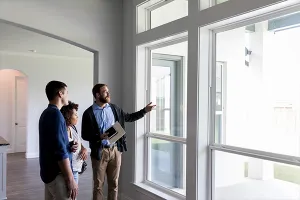Don’t look now, but there’s a robot in your office. It’s your computer printer. Happy to print your spreadsheets, this familiar little robot now has cousins, strange new machines with far bigger jobs in mind. How big? Your next office building just might be built by one.
By now, news of 3D printing technology is familiar. Making the leap from 2D printing of ink on paper, new “printers” are using molten plastic to build real objects with height, depth and breadth. The question of how big these objects can be is a question of how big the robot doing the printing can be. As it turns out, the robot can be big enough to build a commercial building. It’s not quite 3D printing -- a better term for it is automated building construction -- but the principle is the same: start with a computer file, end up with an object.
What’s Different, What Isn’t
To clearly understand the relationship between 3D printing and automated building construction, imagine something familiar from our industry: a tabletop model showing off a proposed commercial construction project. Typically, a tabletop model is made of pieces of hand-cut plastic or foam. In the tradition of architectural modeling, these pieces are cut, shaped and detailed by hand. With the arrival of 3D printing technology, this tradition changes. 3D printing can be used for model making in two main ways: print-and-assemble or print-whole.
Print-and-assemble
In print-and-assemble model making, tabletop model pieces are fabricated inside a 3D printer machine, one layer of molten plastic at a time. Starting with a computer representation of the piece, drawn in three dimensions by the architect, an operator feeds the digital drawing to a tabletop-sized 3D printer attached to the computer. The printer — a robot similar to the kinds you may have seen on factory assembly lines — starts up a dance where it melts drops of plastic that quickly harden, layer by layer, into the shape of the 3D drawing. Complex shapes, simple corners, tops and bottoms and sides all take form in plastic as the robot does its work. When the 3D printer is finished, a completed model part -- a wall section or a balcony for example -- is now available to be assembled into the model, a job which is finished by hand.
In print-and-assemble model making, the size of the 3D printer itself can be modest. A final model that might measure three feet by three feet at the ground and rise three feet into the air can be assembled out of smaller parts - wall sections, floors, cutaways – that measure a few inches across. 3D printers that produce pieces that measure only a few inches across are very affordable -- more expensive than paper printers to be sure, but are not massive capital expenses.
Print-Whole
In print-whole model making, more of the work is done by a bigger machine. First a 3D drawing is made -- not of a pediment or a facade section, but of an entire commercial building model, with external detail. The 3D printer output could be the same as before – three feet across by three feet deep by three feet high – or even greater. Because the whole model is being printed at once, this requires a larger and far more expensive 3D printer. Outside of the greater printer size requirement, the 3D printing process is the same as in print-andassemble. A detailed drawing of the entire model is fed from a computer to a 3D printer large enough to output the entire model.
From Printing Models To Printing...Motels
Now, imagine the largest 3D printer you can, outdoors, on wheels, two stories tall or bigger - big enough to print-whole a strip mall, a motel or a house. Instead of molten plastic, this giant 3D printer uses concrete to build walls, a mix delivered by hose from a truck on a construction site. And instead of models, it produces standing buildings -- whole shells including embedded conduits for electrical, plumbing and HVAC.
It’s exactly this beast that Dr. Behrokh Khoshnevis has designed and built. Only you won’t find it called 3D printing. He calls his invention -- a form of automated construction -- by the name “contour crafting.”
Even though the principles of contour crafting are similar to print-whole 3D techniques, Khoshnevis, a civil engineering professor based in Los Angeles, picked a different name to help distinguish his technology from 3D printing and the too-small tabletop-scale impressions that come with it. “Every day I’m getting calls from construction companies, development companies, real estate companies. They want to come see,” Khoshnevis explains when asked about the technology’s commercial applications. It’s no surprise a line is forming outside his office — the invention promises to radically alter the economics of new construction, cutting it to a fraction of current levels.
No Longer “One And Done”
A major advantage to contour crafting is its ability to automatically produce a series of buildings in a single run. While the buildings do not have to be the same design, as long as they conform to maximum width and height dimensions of the contour crafting robot, the vision of a machine building an entire block of structures is now a reality. Efficiencies and cost controls associated with single-structure development may now be applied to entire groups of structures.
This rapid and economical vision of development of an entire neighborhood all at once neighborhood came to Khoshnevis after a 2003 earthquake destroyed the city of Bam in his native Iran. The widespread devastation of that disaster left 100,000 homeless and prompted Khoshnevis to develop a fast and economical method to restore a standard of earthquake-durable shelter to the stricken. It’s no small feature that earthquake resistance is one of any number of construction standards that can be “baked in” to contour crafted structures – and into entire areas all at once.
Rewriting The Rules Of Traditional Construction
Contour crafted buildings aren’t complete when the robot finishes -- electrical, HVAC, plumbing, doors, windows, all need to be added to complete a project. But the inventor says the costs of construction can still be cut by as much as 80% with contour crafting. “Usually [contour crafting] is just focusing on the shell of the building. You don’t do all the detail work, you don’t do finish work, you don’t do molding. But gradually you’ll do all of that. So eventually the cost will come down significantly to about a quarter or fifth of what you pay now.”
Want to learn even more?
Take A Deeper Dive
Watch the entire Dr. Berokh Khosnevis TEDx Talk referenced in this SideBar at: http://www.youtube.com/watch?v=25rrNrkn2pg
Savings on construction materials and crew for the shell fabrication are only part of the picture.
In a recent TEDx Talk, Khoshnevis pointed out a list of construction industry problems and costs that contour crafting goes a very long way toward solving.
Costs associated with the inefficiency of hand construction, work site hazards to humans, the waste generated and the constant challenge of staying on schedule and on budget all are addressed head-on by contour crafting:
WORKER HAZARDS:
Without manual wall erection, and with floor installation aided by robotics, opportunities for workplace injuries are deeply reduced.
WASTE:
Contour crafting uses a liquid medium to create its walls: no more or less material than is necessary is pumped by the system. Cleanup is minimal.
SCHEDULE AND BUDGET:
Khoshnevis estimates that using contour crafting, a 2,500 square foot structure will take 20 hours. That’s hours - not weeks. That means the only construction type that goes up faster than contour crafting is emergency construction.
CORRUPTION:
Increasingly punitive fines levied by regulators against construction companies operating globally means contour crafting presents huge opportunities to streamline the trades management process and avoid traditional losses to corruption. A recent PriceWaterhouse Coopers report on corruption prevention in the construction industry cites a “Bribe Payers Index” which identifies industry sectors most likely to bribe a public official. The top sector is Public Works contracts and construction.








